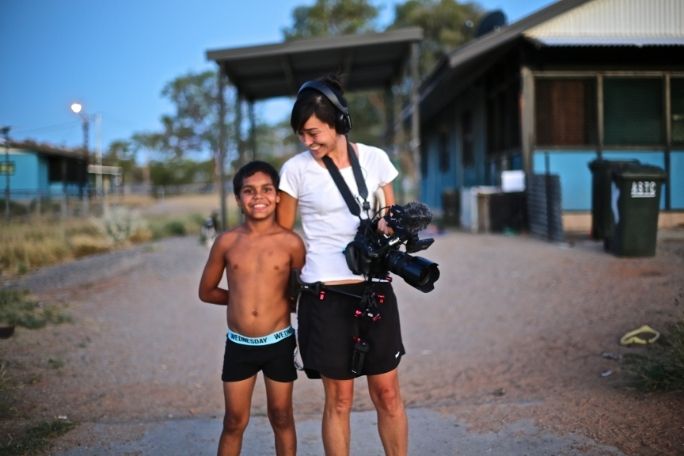Lesson summary
In this lesson, students explore the powers that editors and filmmakers have when representing people who are the subjects of documentaries. They will explore In My Blood It Runs as a case study where a special approach to self-determination was used. They will then unpack the concept of self-determination and its importance for Aboriginal and Torres Strait Islander communities.
Learning intentions:
Students understand...
- the complex and collaborative relationship between documentary filmmakers and the people featured in these films
- how editors can make meaning in a film
- how representations in film can relate to political issues
- how film techniques can communicate power relationships and political ideas
- the importance of self-determination when working with Aboriginal and Torres Strait Islander peoples to create films
Success criteria:
Students can...
- identify editing techniques in film
- suggest their own edits to change a shot’s meaning
- relate editing decisions in In My Blood It Runs to its historical and cultural context
- identify guidelines for how to work ethically with Aboriginal and Torres Strait Islander communities to create films
Lesson guides and printables
Lesson details
Curriculum mapping
Australian curriculum content descriptions:
Year 9 English:
- Explore and reflect on personal understanding of the world and significant human experience gained from interpreting various representations of life matters in texts (ACELT1635)
- Investigate and experiment with the use and effect of extended metaphor, metonymy, allegory, icons, myths and symbolism in texts, for example poetry, short films, graphic novels, and plays on similar themes (ACELT1637)
- Analyse how the construction and interpretation of texts, including media texts, can be influenced by cultural perspectives and other texts (ACELY1739)
- Apply an expanding vocabulary to read increasingly complex texts with fluency and comprehension (ACELY1743)
- Explore and explain the combinations of language and visual choices that authors make to present information, opinions and perspectives in different texts (ACELY1745)
Year 10 English:
- Analyse and explain how text structures, language features and visual features of texts and the context in which texts are experienced may influence audience response (ACELT1641)
- Identify, explain and discuss how narrative viewpoint, structure, characterisation and devices including analogy and satire shape different interpretations and responses to a text (ACELT1642)
- Analyse and evaluate how people, cultures, places, events, objects and concepts are represented in texts, including media texts, through language, structural and/or visual choices (ACELY1749)
- Evaluate the social, moral and ethical positions represented in texts (ACELT1812)
Syllabus outcomes: EN5-2A, EN5-3B, EN5-4B, EN5-7D, EN5-8D.
General capabilities: Critical and Creative Thinking, Personal and Social Capability, Intercultural Understanding
Cross-curriculum priority: Aboriginal and Torres Strait Islander Histories and Cultures (OI.6)
Relevant parts of Year 9 & 10 achievement standards: Students interpret, create, evaluate, discuss and perform a wide range of literary texts in which the primary purpose is aesthetic, as well as texts designed to inform and persuade. These include various types of media texts, including newspapers, film and digital texts, fiction, non-fiction, poetry, dramatic performances and multimodal texts, with themes and issues involving levels of abstraction, higher order reasoning and intertextual references. Students develop a critical understanding of the contemporary media and the differences between media texts.
This lesson is part of the wider unit of work In My Blood It Runs
Time required: 70 mins
Level of teacher scaffolding: Medium – facilitate class discussion
Resources required
- Butcher’s paper and markers (one per group)
- Device with internet access capable of displaying videos for the whole class
- Project Approach – one copy per students
- Student Worksheet
Skills
This lesson is designed to build students’ competencies in the following skills:
- Critical thinking
- Cultural understanding
Additional info
We recommend that before you teach this lesson, you have taught one or both of the first lessons in the sequence (Identity and Diverse Perspectives), accessed the free professional learning resource, which has been co-developed by Reconciliation Australia’s Narragunnawali team, and watched the film with your class.
Cool.org would like to thank the In My Blood It Runs Advisory Committee who supported the writing of this resource. Special thanks to Alanna Raymond, Tessa Keenan, Stephanie Woerde, Esma Livermore and Julie Bover from Reconciliation Australia, Alex Shain from Shark Island, Maria Katsabanis from Australian Human Rights Commission, Renee Phillips from National Indigenous Youth Education Coalition, and Keren Shlezinger.


Welcome back!
Don't have an account yet?
Log in with:
By signing up to Cool.org you consent and agree to Cool's privacy policy to
store, manage and process your personal information. To read more, please see
our privacy policy here(Opens in new tab).
Create your free Cool.org account.
Many of our resources are free, with an option to upgrade to Cool+ for premium content.
Already have an account?
Sign up with:
By signing up to Cool.org you consent and agree to Cool's privacy policy to
store, manage and process your personal information. To read more, please see
our privacy policy here(Opens in new tab).